🎯 Learning Objectives
By the end of this lesson, learners will be able to:
✅ Know who to contact when a newborn shows red flag signs of jaundice
✅ Use available hotlines, CHW networks, and local health contacts
✅ Understand the importance of speed and clarity in communication
✅ Help caregivers remain calm but act quickly
📞 Why Contacting the Right Person Matters
When a baby shows danger signs, minutes can save a brain. Knowing who to call, text, or send to can be the difference between:
-
Full recovery vs. brain damage
-
Life vs. death
-
Long hospital stay vs. quick discharge
🧑⚕️ Who to Contact – Priority List by Context
1. Local Community Health Worker (CHW) / Village Health Team (VHT)
-
Trained to assess jaundice and refer quickly
-
Often closest to families
-
Can help with transport, call ahead, or escort
🗂 How to find them:
-
CHW/VHT directory at local facility
-
Ask at village church, mosque, or chief’s compound
-
Posters at rural health posts
2. Nearest Health Facility or Maternity Centre
-
Nurse-midwife can assess and refer
-
Small clinics may not have phototherapy but can start warm care and communicate with higher centres
📱 Tip: Save facility nurse or matron’s number on caregiver’s phone or write in child’s health card.
3. District or Regional Referral Hospital (with NICU)
-
These centres have phototherapy, testing, or blood banks
-
CHWs may already have referral contact sheets or WhatsApp groups
🌐 Example resources:
-
Nigeria: https://hfr.health.gov.ng
-
Ghana: https://kbth.gov.gh
-
Uganda: Check via VHT or Mulago Hospital
4. National or Regional Emergency Hotlines
| Country | Hotline | Purpose |
|---|---|---|
| 🇰🇪 Kenya | 1195 (Free) | Maternal, newborn, GBV emergencies |
| 🇳🇬 Nigeria | 112 | General health emergency response |
| 🇺🇬 Uganda | VHTs via Local Council 1 | Community newborn emergency action |
| 🇬🇭 Ghana | 311 (MoH Call Line) | Health info, referrals, CHW contact help |
5. OneWomb CHW Network (if available)
-
Community-verified, trained CHWs with access to:
-
Printed and digital referral tools
-
WhatsApp voice referral scripts
-
Tracking and follow-up system
-
📩 Contact your local OneWomb partner nurse or CHW to connect.
💬 CHW/Clinician Call Script (Sample)
“Hello, my name is [NAME]. I have a newborn baby with yellow eyes and palms, not feeding, very sleepy. We are in [LOCATION]. The baby is 2 days old. Please advise where we can come immediately for testing and phototherapy.”
🌍 Real Case – Nigeria
In Calabar, a mother noticed her baby had yellow eyes on Day 1. The family called a TBA, who contacted the local CHW. The CHW called UCTH directly and shared a referral note via WhatsApp. The baby received phototherapy within 3 hours. Brain damage was prevented.
📌 Keep These Numbers Handy (Fillable Template)
| Name | Role | Phone | Location |
|---|---|---|---|
| CHW/VHT | |||
| Nearest Clinic | |||
| Referral Hospital | |||
| Emergency Hotline | |||
| OneWomb Nurse (optional) |
👉 Print this in the Jaundice Home Monitoring Card (Lesson 3).
📝 Mini Quiz – Who to Contact
Q1. Who is the FIRST person a rural family should contact for a jaundiced baby?
A. Traditional healer
B. Community Health Worker (CHW)
C. School teacher
D. Taxi driver
✅ Answer: B
Rationale: CHWs are trained to assess and refer newborns quickly and appropriately.
Q2. Which hotline is used in Kenya for newborn and maternal emergencies?
A. 911
B. 112
C. 1195
D. 0800-CARE
✅ Answer: C
Rationale: 1195 is a national, toll-free maternal/newborn care line.
Q3. Why is it important to call ahead to the hospital before bringing the baby?
A. To see if there’s food
B. To avoid being chased away
C. To make sure care is ready and avoid delays
D. To make sure the nurse is friendly
✅ Answer: C
Rationale: Calling ahead prepares the hospital to act fast and avoids long waiting times.


